Magazine
Living Laboratory
The staff at the National Audubon Society’s Paul J. Rainey Sanctuary in Vermilion Parish stand on the frontline of the battle for Louisiana’s coast.
Published: December 1, 2016
Last Updated: August 22, 2023
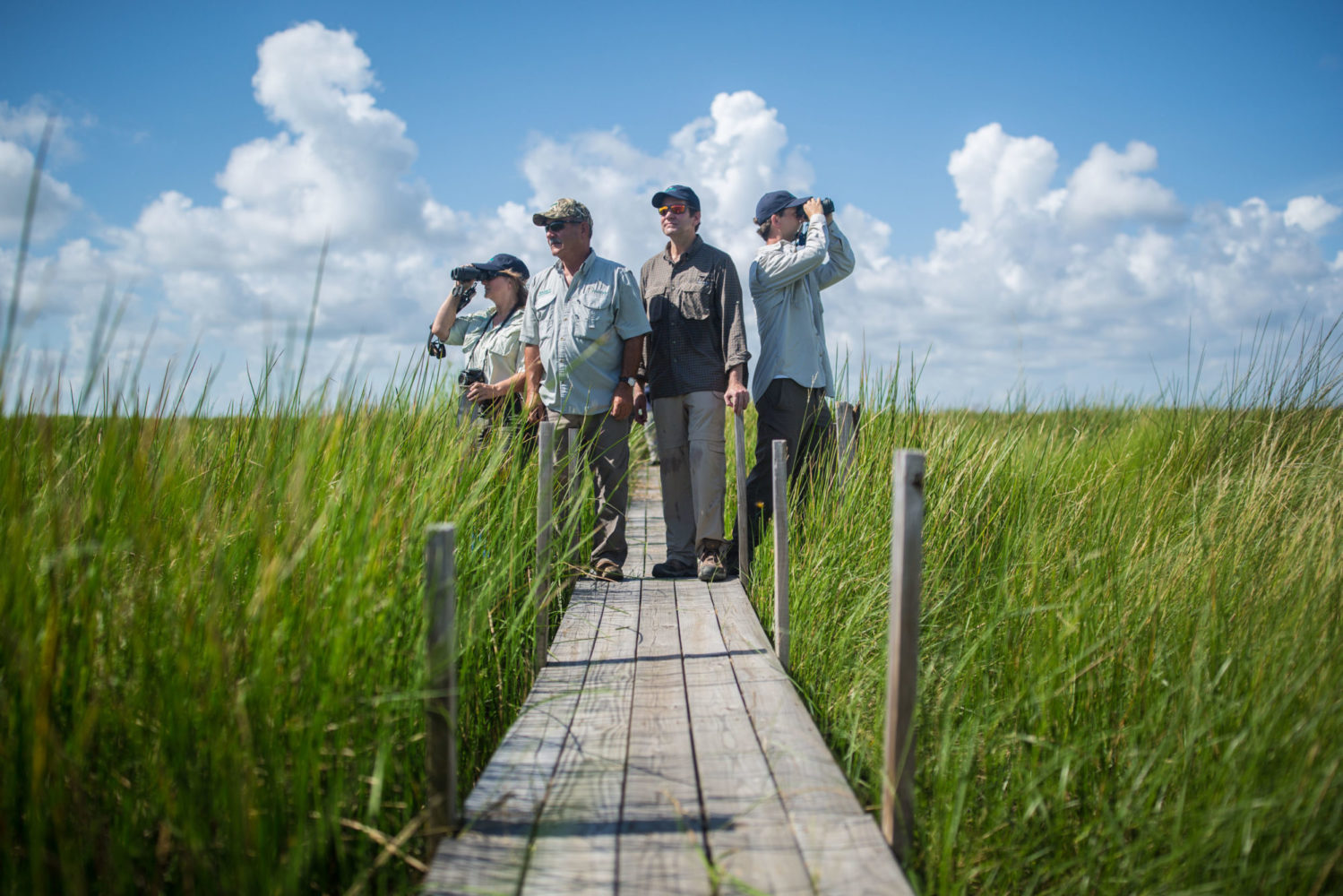
Zack Smith
The staff of Audubon Louisiana at the Rainey Sanctuary in Vermilion Parish.
Timmy Vincent cut the airboat’s engine and surveyed the water of Cole’s Bayou in Vermilion Parish. “They had cattle drives in these marshes,” he told his visitors. As the senior manager at the National Audubon Society’s Paul J. Rainey Wildlife Sanctuary, Vincent knows every inch of the 26,000-acre preserve. “Mr. Cole was a trail boss. They’d drive them north, hit the Old Spanish Trail, U.S. 90. There was nothing to stop them, just a few natural bayous they had to swim.”
For a moment, I tried to visualize them, the cattle crossing the Gulf of Mexico from Texas on a barge, grazing on the beach before the cowboys and horses guided them on to Lake Charles or New Orleans. This was difficult to imagine, however, because like so many places along the coast of Louisiana, what was once marsh is now open water. The tiny islands of swamp grass and morning glories scattered around Cole’s Bayou couldn’t support a man’s weight, much less a thundering herd.
At Rainey, the National Audubon Society has developed, implemented and exported the best practices in land management for almost a century. But as coastal erosion threatens this part of southwest Louisiana, managing land becomes a complicated challenge. The state’s land-loss crisis is complex and mounting: more than 1,880 square miles have disappeared since the 1930s. Long an incubator for conservation strategies, the sanctuary is now a laboratory for new weapons in Louisiana’s struggle to stave off the sea. The successes at Rainey will influence the choices made by other landowners and communities along the Gulf Coast.
A History of Conservation
The National Audubon Society took ownership of the land in 1924 in one of the many pivotal transactions brokered by Edmund Avery McIlhenny, the Tabasco heir, Arctic explorer and, according to Vincent, “father of conservation in Louisiana.” In the early 1900s McIlhenny was commissioned by Paul J. Rainey to purchase land for geese hunting. A dashing figure in his own right, Rainey was the son of a Midwestern coal baron but preferred hunting lions with dogs in Africa to running the family business. McIlhenny agreed to manage the land on the condition that he would receive one-third of the property upon Rainey’s death. When Rainey died in 1923, on a boat bound for Cape Town, McIlhenny selected his portion of the best hunting grounds, and Rainey’s sister donated the remaining land plus $24,000 to the National Audubon Society. The pristine corner of the Chenier Plain, just south of Vermilion Bay, became Audubon’s first wildlife refuge and remains its largest.
The land stretching from Intracoastal City to the Gulf was a compelling choice, positioned at the very base of the Mississippi Flyway, the route taken by millions of migratory birds as they travel back and forth to Central and South America. “Many migratory birds treat this as the first pit stop as they cross the Gulf of Mexico,” said Erik Johnson, Audubon Louisiana’s director of bird conservation. A native of Pittsburgh who studied biology at Louisiana State University, Johnson has an ornithologist’s dream job, analyzing the birdlife at one of the world’s most robust locations. “It’s a 600-mile non-stop flight that can take them 18 hours in good weather. These are songbirds that weigh as much as five pennies. This is the first land they see.” More than 200 species of birds spend time every year at Rainey.
The National Audubon Society was founded in 1905 to protect birds and conserve and restore their natural ecosystems; Audubon Louisiana, which oversees operations at Rainey, is one of 22 state programs. Hunting is prohibited at Rainey, and public access is limited—only about 100 people visit the sanctuary each year. Cougars, coyotes, bobcats, otters, muskrat and nutria call Rainey home, but Vincent is its only full-time human resident.
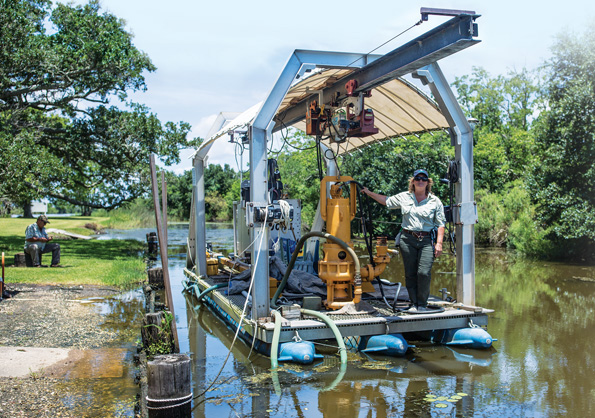
Karen Westphal aboard the “John James” dredge. Photo by Zack Smith
He grew up in nearby Erath and started visiting the property in 1969, forming a close relationship with Lonnie Lege, the sanctuary’s manager for 40 years. “I came here with an open mind and learned techniques from him about marsh management that you couldn’t learn at a university,” he says. “I was very observant, and I asked questions all the time and gained his trust.” In 1996 Vincent became only the fourth manager in Rainey’s history.
The solitude of life at the manager’s camp suits Vincent’s voracious reading habits. To understand Rainey’s history, he recommends “The Geese Fly High” by Florence Page Jaques, a Minnesotan who visited Rainey with her husband in 1939. Jaques rhapsodized about the landscape and its inhabitants: “Then the fog broke slightly and we caught glimpses of great wavering V’s against the blue. Here was the vision we had sought—hundreds of blue and snow geese rushing south through the cloudy wraiths.”
My trip to Rainey in July 2016 wasn’t ideal for spotting geese, which prefer to visit Rainey in the colder months, but Johnson identified 35 species of birds during our six-hour tour, including roseate spoonbill, tricolored heron, orchard oriole, Forster’s tern, and an osprey that tracked us down one canal. This part of Louisiana is a critical nesting habitat for coastal water birds. In April 2016, for the first time since 1939, a whooping crane was hatched in the wild in Louisiana in the nearby White Lake Wetlands Conservation Area. The chick was the culmination of a project led by the Louisiana Department of Wildlife and Fisheries to reintroduce the species into natural habitats, including several birds released at Rainey. “We’ve seen that cycle of loss and recovery throughout the history of the sanctuary,” says Johnson. Together with Vincent and Audubon Louisiana project manager Karen Westphal, Johnson continues to research the green heron population, which has quietly declined, in the last 50 years, by 50 percent in the southeastern United States. “They’re extremely under-researched. We’ve banded eight times as many green herons in three years of research than had been banded in all of the U.S. in the last 100 years,” he notes with subtle pride.
Audubon’s careful, ongoing interventions have helped to sustain wildlife at Rainey despite numerous intrusions. The complicated landscape required herculean efforts and attracted far-flung visitors seeking creative solutions to land management. John M. “Frosty” Anderson, director of the National Audubon Society’s Wildlife Sanctuary Department from 1966 to 1990, accompanied contingents from the Royal Society for the Protection of Birds in Scotland, Cree Indians from Manitoba, Rotarians from Holland, and several species of Louisiana politicians. In his collection of cheeky reports to the home office, Anderson chronicled the uproarious adventures and native wisdom of the Rainey staff. (In the 1970s, the sanctuary played an integral role in the restoration of the region’s alligator population after overharvesting caused a drop. “A mad alligator in a boat with three human-type critters gets crowded more than somewhat,” observed Anderson.)
“Water and birds don’t recognize private property boundary lines, so neither should we when we’re looking at large scale conservation.” Doug Meffert, Executive Director, Audubon Louisiana
But amid Anderson’s detailed recaps of the nightly seafood feasts at the camp, there were hints of a coming crisis. Hurricanes in the 1980s damaged levees, destroy marsh and kill migrating birds. Anderson made note of another threat: “Apparently navigation canals and other man-made changes have sped up the rise and fall of tides in the marshes.”
Scientists in Louisiana began to sound alarms about coastal land loss in the 1970s. The crisis looms over any discussion of the state’s future, with much of the public’s attention focusing on southeast Louisiana and the changing dynamics of the Mississippi River Delta. Yet southwest Louisiana faces its own dire forecast, and Rainey’s complex landscape bears the scars of dramatic land loss.
After a century of industrial development, southwest Louisiana is now spiderwebbed with canals, including the Gulf Intracoastal Waterway built in the 1910s and the Freshwater Bayou Channel in the 1960s. The canals fatefully altered the region’s hydrology, creating a volatile filling and flushing system and increasing salinity. “Where the tidal range used to be six to eight inches, now it can be five feet,” says Westphal. “That flushes the marsh; it takes everything with it.” The water can flush back out in a matter of hours, putting stress on marsh plants, and removing more sediment than it deposits. Westphal describes Hurricanes Rita and Ike as a one-two punch to Rainey’s coast and interior: Rita inundated the sanctuary with saltwater in 2005, and Ike ripped out acres of weakened marshland. The dangers of coastal erosion were unmistakable. “We saw for the first time these events that caused massive land loss,” says Vincent. “Rita and Ike really opened our eyes.”
Dedicated to protecting fragile wildlife habitats, Audubon needed to find solutions. The millions of migratory birds who depended on Rainey were counting on it.
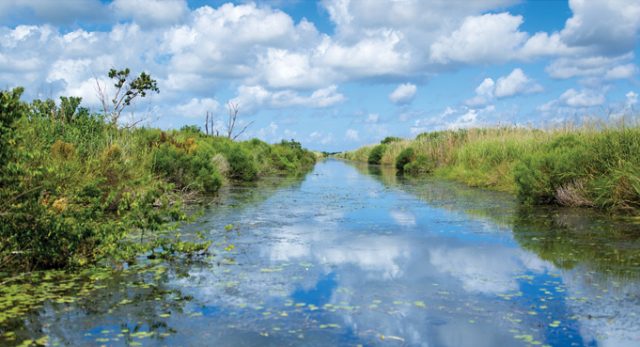
Photo by Zack Smith
A Turning Point for Coastal Restoration
The efforts to combat coastal land loss crisis have evolved over the last twenty-five years, and Louisiana is about to witness a significant increase in the pace of work. Senator John Breaux visited Rainey in 1990 of the Coastal Wetlands Planning, Protection and Restoration Act (CWPPRA), also known as the Breaux Act. The landmark federal legislation established a funding source for preserving the nation’s coastal wetlands. In the last ten years the state has constructed 52 miles of barrier islands and berms, benefitted 30,000 acres of land, and improved 247 miles of levees. More recently, the April 2016 settlement between the United States and BP included $9 billion for coastal restoration projects in Louisiana. The money will serve as a catalyst for the state’s Coastal Master Plan, which combines analysis of the crisis with the groundwork for large-scale engineering efforts. While the BP settlement provides a sizable down payment, the estimated bill for the Master Plan projects could total $100 million. Long under siege, Louisiana is entering a new stage in the desperate fight for its very survival.
There exists no one-size-fits-all solution for the highly diverse ecosystems of Louisiana’s coastal parishes. Along the Mississippi River in southeast Louisiana, sediment diversion is an enticing option. Advocates propose unleashing the river at strategic points, allowing it to once again deposit sediment in the Delta to replace lost wetlands. Opponents argue that the diversions disrupt the salinity levels needed for raising oysters, thereby devastating communities who depend on the seafood industry. In southwest Louisiana, the debate is moot: there’s no Mississippi River to harness, no endless supply of land-building sediment to access. “Our strategy here is to hold onto what we’ve got, because if we lose it, it’s going to be really hard to get back,” said Vincent. Facing a different form of land loss, communities in the region must devise other solutions.
Rainey has found common cause with its neighbors. Approximately 85 percent of Louisiana’s coastline is privately owned. Five years ago, Audubon joined with fellow landowners in the region to form the Rainey Conservation Alliance, a coalition that includes E.A. McIlhenny Enterprises, Sagrera Lands and Vermilion Corporation. The members cooperatively manage 185,000 acres between the mouth of the Atchafalaya River and the Mermentau River.
“Water and birds don’t recognize private property boundary lines, so neither should we when we’re looking at large-scale conservation,” says Doug Meffert, executive director of Audubon Louisiana. Individual land managers share information and prioritize projects, and the Alliance presents a unified front to the government officials. “As landowners here in Louisiana, we have skin in the game in restoration in Louisiana. We can take restoration techniques and export them to not only our neighbors, but to landowners throughout the state.” This spirit of cooperation has borne results: the coalition has secured more than $65 million for restoration projects.
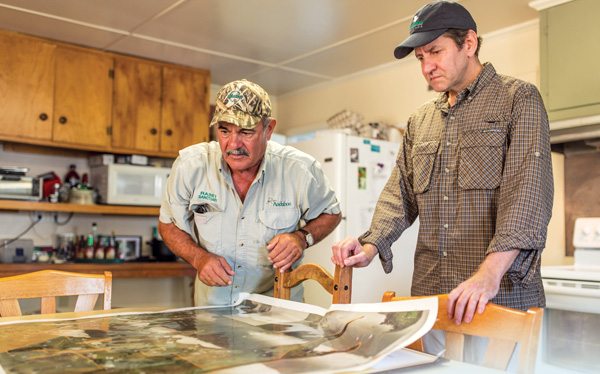
Audubon’s Timmy Vincent (left) and Doug Meffert at the Rainey Sanctuary camp. Photo by Zack Smith
One Acre of New Louisiana
The range of projects reflects the complicated landscape. In 2011 the Rainey Alliance acquired the “John James,” a small, state-of-the-art commercial dredge. Javeler Construction Co., Inc., of New Iberia built and donated the finished prototype, estimated to be worth $100,000. Roughly the size of a pontoon boat, the dredge seems an unlikely tool for a massive job. Operated by Vincent and Westphal, the dredge accomplished a practical task: it rebuilt an acre of Louisiana.
The process was simple and slow. The dredge dug sediment from a canal that had filled in, pumped it through a four-inch hose over a levee and deposited the dirt into a stretch of open water left by Hurricanes Rita and Ike.
“Timmy and I did everything,” said Westphal, “pulling hose, moving the hose around with ropes and four-wheelers, operating the machine. We spent a lot of time just sitting on the dredge for hours until one or the other couldn’t stand it and would run ashore to check to see what we did.” They divided the area into containment cells and watched the grass grow in a completed section as they continued the work. Westphal grew up on the Mississippi coast and studied with the late Shea Penland, the influential University of New Orleans coastal geologist. She began flying over the coast in the 1980s. “I was watching that coastline year after year move inland and morph and break open, bays getting bigger and bigger.” She points with satisfaction to the tall grass that’s replaced the water with a robust new patch of Louisiana. “All of that is new land that Timmy and I created.”
The dimensions of the project—restoring an acre of land in two years—might seem like a drop in the bucket, but it set an important example. “We wanted a small dredge that could be handled by landowners—you could do it yourself. We’re a landowner, and we figured if we could do it ourselves, our neighbors could do it themselves.” In many parts of Louisiana’s coastal areas, small-scale marsh restoration is urgently needed in areas of limited accessibility. The dredge burned five gallons a diesel fuel a day. At those prices, victories are within the reach of the many private landowners who can’t wait for state or federal intervention. At Rainey, the innovations attracted more investment. In 2015 Audubon received a National Wildlife Foundation grant to purchase the Amphibex 400 dredge, which took just 10 days to create nine acres of soft mudflat.
Cole’s Bayou is the site for a much larger endeavor. The land once used for cattle drives was weakened by saltwater intrusion, subsidence and breaches in the surrounding levees. In an example of the interior land loss that plagues southwest Louisiana, the recent hurricanes tore the marsh out like old carpet. “This was continuous marsh—there were no lakes here,” says Vincent. “Rita started the gouging out, and Ike finished it off.”
Rainey, McIlhenny and ExxonMobil all own portions of Cole’s Bayou and the adjacent lands. In January 2017, after five years of planning, analyzing the environment and negotiating with the involved parties, the National Oceanic and Atmospheric Administration and the state of Louisiana will begin a CWPPRA-funded, $25.6 million restoration project in the marsh. Sediment dredged from Vermilion Bay will create 365 acres of brackish marsh in the shallow open water and nourish 53 acres of existing brackish marsh. New control structures will combat the rapid filling and flushing that’s damaged the natural hydrology. Pipes will encourage additional freshwater and sediment to flow into the bayou and manage the flow of saltwater back out to sea.
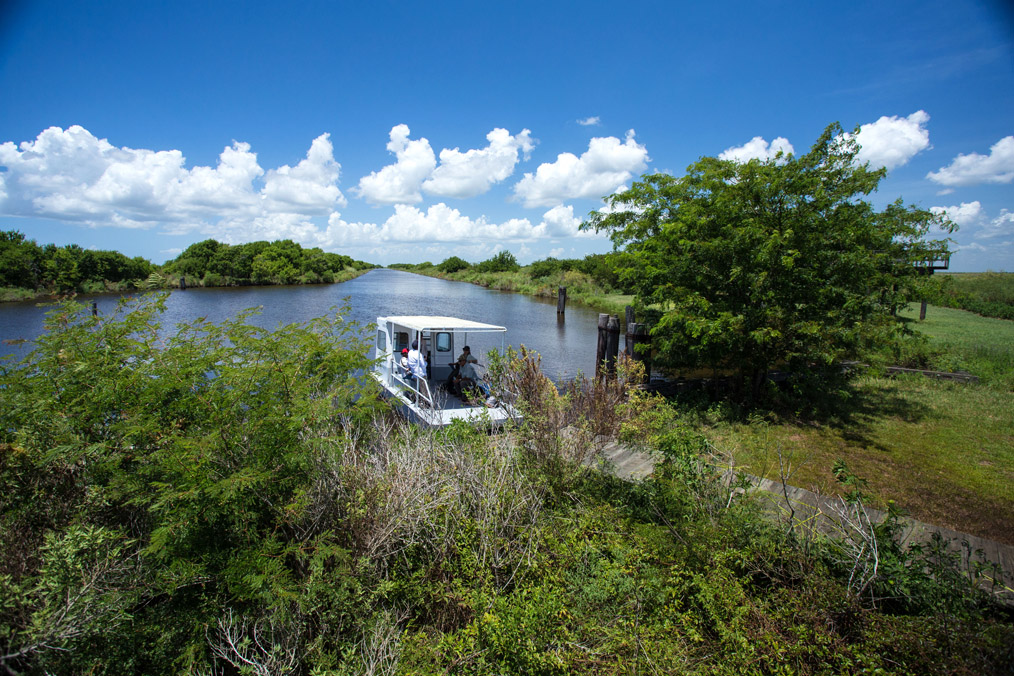
Photo by Zack Smith
Projects like these can be replicated in Louisiana and exported to vulnerable wetlands around the world. “Many coastal areas are experiencing sea level rise and salt water intrusion,” says Meffert. “We’ve been contacted by Minnesota to ask how they can use their dredged material to rebuild their wetland areas.”
Meffert likes to quote the eminent conservation biologist Thomas E. Lovejoy: “If you take care of the birds, you take care of most of the big problems in the world.” Coastal Louisiana’s big problem represents a grave threat to the state’s very survival as well as to the national economy, which reaps billions of dollars each year from Louisiana’s wetlands. As the battle escalates, invaluable solutions may come from an imperiled parcel of land wisely set aside for taking care of the birds.
